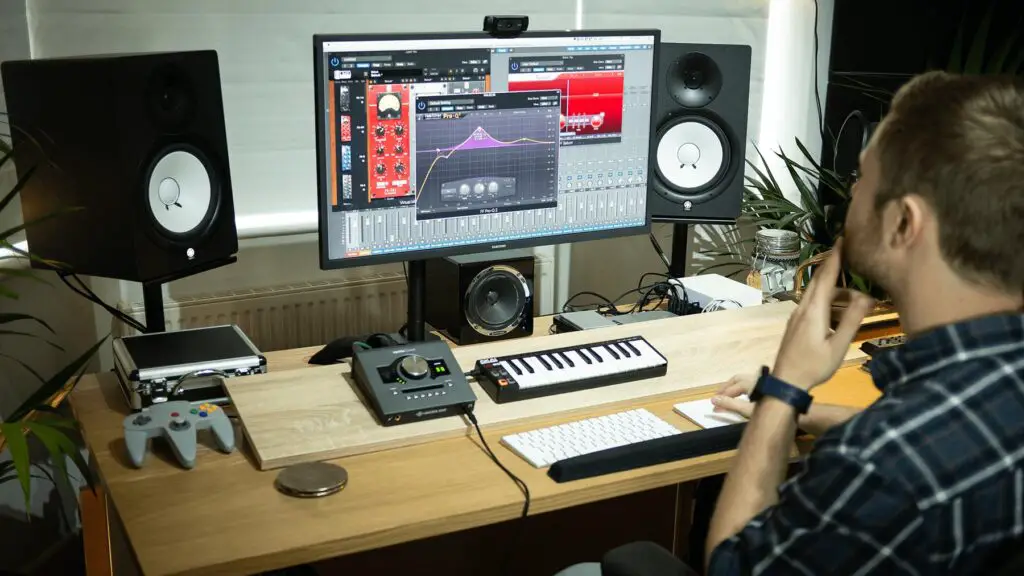Are you looking for the best program to produce music? Look no further, as we’ll be discussing the best digital audio workstations (DAWs) for music production in 2021. DAWs are critical tools for music producers, and choosing the right one is essential to achieve the desired result. In this article, we’ll be comparing the most popular DAWs available, their features, and which ones are best suited to your music production needs. By the end of this article, you’ll have a clear understanding of which DAW to choose for your music production.
Table of Contents

Overview of Digital Audio Workstations (DAWs)
Definition of DAWs
Digital Audio Workstations (DAWs) are software applications that allow music producers, composers, and audio engineers to record, edit, and mix digital audio files on a computer. A DAW is the central hub of a music production studio, where the user can create, manipulate, and arrange sounds to produce a finished product.
Importance of Using a DAW
DAWs have revolutionized the music industry by democratizing music production. Prior to the advent of DAWs, music production was an expensive and time-consuming process that was only accessible to a select few. With DAWs, anyone with a computer and an audio interface can create professional-sounding music in their own home studio.
The Evolution of DAWs
DAWs have come a long way since the first computer-based recording systems were introduced in the 1970s. The first DAWs were very basic and could only record a few tracks at a time. Over time, DAWs became more sophisticated, allowing for more tracks, better sound quality, and more advanced editing features.
Types of DAWs
There are several types of DAWs available, each with its own strengths and weaknesses. Here are the three main types of DAWs:
- Track-based DAWs: These are the most common type of DAWs. They are designed to work with audio tracks, which are arranged in a linear timeline. Examples of track-based DAWs include Pro Tools, Logic Pro X, and Cubase.
- Loop-based DAWs: These DAWs are designed for creating music using pre-made loops and samples. They are popular among electronic music producers and beatmakers. Examples of loop-based DAWs include Ableton Live and FL Studio.
- Hybrid DAWs: These DAWs combine the features of track-based and loop-based DAWs. They allow you to work with audio tracks and loops/samples interchangeably. Examples of hybrid DAWs include Studio One and Reason.
DAWs and the Music Industry
DAWs have become an essential tool for music production in the modern era. They have made it possible for independent artists to produce and distribute their music on a global scale without the need for a record label. DAWs have also enabled musicians to collaborate remotely, allowing them to work together on a project from different parts of the world.

How to Choose the Best DAW for Music Production
Choosing the right digital audio workstation (DAW) for your music production needs may seem overwhelming, but it doesn’t have to be. Here are some factors to consider when choosing a DAW:
Compatibility
It is important to make sure the DAW you choose is compatible with your computer’s operating system. Some DAWs only work on Macs, while others only work on PCs. Additionally, make sure your computer meets the minimum system requirements for the DAW.
User Interface
The user interface of a DAW can greatly affect your workflow. Look for a DAW with a user-friendly interface that you find intuitive and easy to use. Consider what type of music you’ll be producing and how the interface can help streamline your process.
Features
The features of a DAW can vary greatly and should be considered carefully. Do you need to record live instruments? Do you need advanced MIDI editing features? Do you need a built-in sampler or synthesizer? Look for a DAW that has the features you need to make your music production process smoother and more efficient.
Personal Experience with DAWs
Here is an example of how a personal experience with DAWs can help in choosing the right one:
When I first started producing music, I found the number of DAWs available to be overwhelming. I did some research and decided to try out Logic Pro X. It was intimidating at first, but after watching tutorials and experimenting, I began to understand the software. One feature I loved about Logic Pro X was the built-in virtual instruments, which saved me time and money as a singer-songwriter. Additionally, the MIDI editing capabilities allowed me to experiment with different melodies and make changes quickly.
Overview of Popular DAWs
Here’s an overview of some of the most popular DAWs:
- Pro Tools: A professional-grade DAW with advanced editing features and excellent sound quality.
- Logic Pro X: A popular DAW among Mac users with a user-friendly interface and built-in virtual instruments.
- Cubase: A versatile DAW used by many professional producers with advanced MIDI editing features and excellent audio quality.
- Ableton Live: A loop-based DAW used by many electronic music producers with real-time performance capabilities and built-in audio effects.
- FL Studio: Another loop-based DAW popular among electronic music producers with an easy-to-use interface and built-in virtual instruments.
Comparison of DAWs
Here’s a comparison of the DAWs we just discussed:
| DAW | Strengths | Weaknesses | Price |
|---|---|---|---|
| Pro Tools | Advanced editing features, excellent sound quality | Expensive, steep learning curve | $299 – $999 |
| Logic Pro X | User-friendly interface, built-in virtual instruments | Only available on Mac, limited audio editing features | $199.99 |
| Cubase | Advanced MIDI editing features, excellent audio quality | Expensive, steep learning curve | $99 – $579 |
| Ableton Live | Real-time performance capabilities, built-in audio effects | Not ideal for recording live instruments, limited editing capabilities | $99 – $749 |
| FL Studio | Easy-to-use interface, built-in virtual instruments | Limited audio editing features, not ideal for recording live instruments | $99 – $899 |
Best DAWs for Different Types of Music Production
Here are some recommendations for the best DAWs for different types of music production:
- Rock/Pop: Pro Tools, Logic Pro X, or Cubase
- Electronic/Dance: Ableton Live or FL Studio
- Hip-Hop/Rap: FL Studio or Logic Pro X
- Classical/Orchestral: Cubase or Logic Pro X
Considering these factors can help you choose the right DAW for your music production needs.

Other Music Production Tools and Software
Besides a good Digital Audio Workstation (DAW), there are other tools and software that can help enhance your workflow and produce better music. Here are some of the most popular ones:
Audio Plugins
Audio plugins are software programs designed to add effects and processing to your audio tracks. These plugins come in different types, including compressors, EQs, and reverbs, among others. They can be used both as standalone software or within your DAW.
Plugins enable you to add specific effects to your audio tracks, adjust sound frequencies, or even emulate the sound of analog gear. Some popular Audio Plugins include Waves, FabFilter, and iZotope.
Virtual Instruments
Virtual instruments are software programs created to simulate real instruments. They are used to create MIDI tracks or to add additional instrumentation to your live recordings. They are a great tool for producers who want to produce music on their computer and don’t have access to live instruments.
Virtual instruments come in different forms, including drums, keys, and strings, among others. They can be used to create realistic sounds, and some virtual instruments allow you to tweak the sound to your preference. Popular Virtual Instruments include Native Instruments’ Kontakt, XLN Audio’s Addictive Drums, and Spectrasonics’ Omnisphere.
Effects
Effects are audio processing tools that add character and depth to your music. They include delay, reverb, and distortion, among others. Effects can be used both as standalone software or within your DAW.
Using effects in your music production can help you create a unique sound, add texture, and create a sense of space. Some popular effects plugins include Soundtoys, ValhallaDSP, and Eventide.
When choosing audio plugins, virtual instruments, or effects, consider the compatibility with your DAW, the price, and the features. Some plugins may only work with specific DAWs or require additional software to run. It’s important to ensure they work with your system before purchasing.
In summary, incorporating audio plugins, virtual instruments, and effects plugins into your music production workflow can help you create a unique sound and enhance the quality of your music.
Sources and Further Reading
To ensure the accuracy and comprehensiveness of the information presented in this article, we utilized various reliable sources, including industry experts, music producers, and online resources. Here are a few links to reputable sources that can provide further reading on the topic:
-
MusicTech.net: This website provides in-depth reviews of different DAWs available in the market, including their features, pros, and cons. It also offers valuable insights from music producers on how to choose the best DAW for your music production needs.
-
RollingStone.com: This article features a list of the best DAWs for music production in 2021, as recommended by music experts. It provides a brief overview of each DAW, along with its key features and benefits.
-
SoundOnSound.com: This website offers a comprehensive guide on how to choose the right DAW for your music production needs. It covers key factors to consider, such as compatibility, user interface, and features, and provides detailed reviews of popular DAWs in the market.
These sources can provide valuable insights and information for those looking to learn more about DAWs and music production software.
Conclusion
In conclusion, selecting the appropriate DAW is vital for your music production endeavors. Consider the factors that we discussed, such as compatibility, user interface, and features, when choosing a DAW. We also provided a comprehensive comparison of the most popular DAWs, as well as our recommendations for the best DAWs suited for different types of music production. In addition, we also discussed other music production tools and software, such as audio plugins, virtual instruments, and effects, that can complement your DAW and enhance your workflow, helping you create better music. It is essential to keep experimenting with different software and tools until you find the perfect combination that works for you.
Don’t forget to check out our other content for more in-depth music production topics and expert tips to take your music to the next level.


